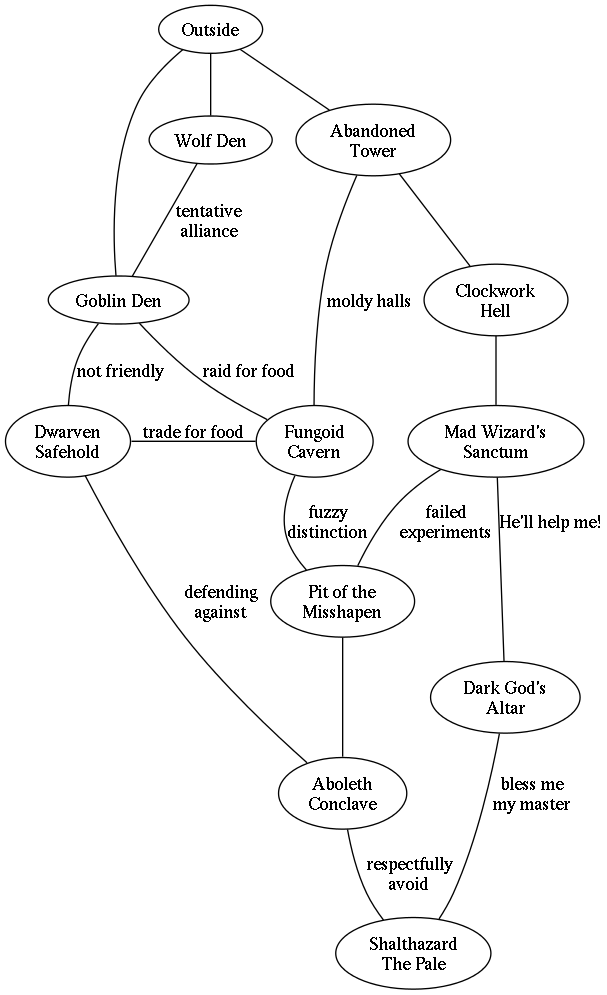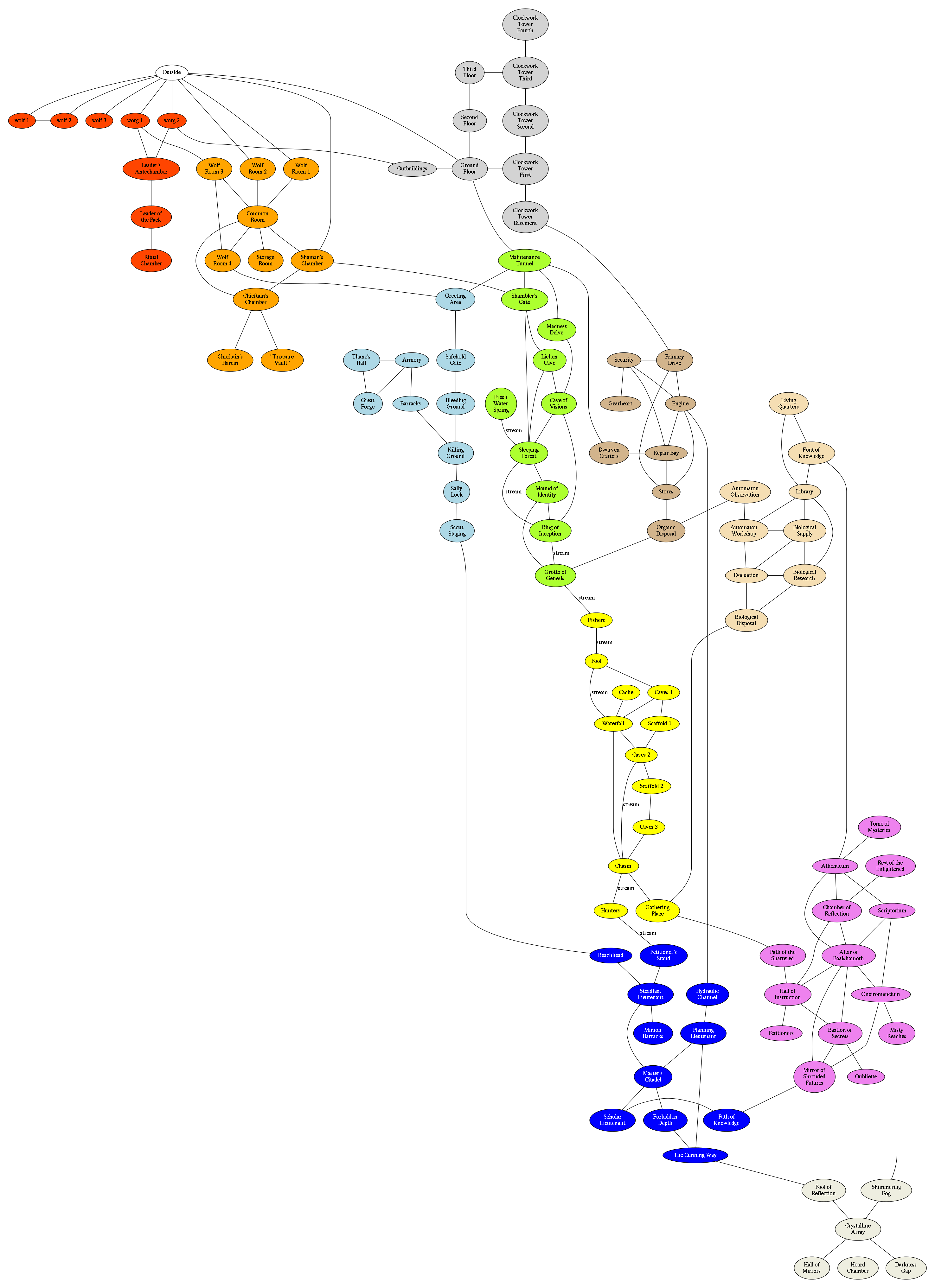It took me a couple days past the end of my weekend to finish this iteration through the megadungeon.
This thing? It’s big.
In total there are 107 nodes in this dungeon. Many would be mapped as single rooms, most could easily be 3-5 rooms. Many could be even more — the three ‘caves’ nodes in the Pit of the Misshapen could easily, easily be a dozen ‘rooms’ each, and many of the nodes in Aristothanes’ Sanctum and the Fane of Baalshamoth could be as well.
I have put about 28 hours’ work into this so far, somewhat less than a week’s work. For a first iteration I think this is pretty usable. Next steps might include:
- Creating encounter lists for each region, identifying likely creatures and events that could be expected to come up in play. First pass would be a list of creatures and events, second might place them into specific nodes and/or wandering monster tables. For instance, in Clockwork Hell you might find dwarves almost anywhere (random encounter) but there will almost always be dwarves found in the ‘Dwarven Crafters’ node near the ‘Repair Bay’.
- Polishing this model. Some of the nodes can be collapsed and merged, some of the relationships are a little dodgy in retrospect.
- Creating a nicer map. GraphViz is a great tool for initial layout so I can see the relationships between the nodes, but they are not all arranged the way I would like to see them. For example, the Dwarven Safehold and the Fungoid Cavern should be ‘more horizontal’, the Wolf Den should ‘surround’ the Goblin Warren, and so on). If I were rendering this for publication I would try to make each region more representative of its actual shape, and possibly construction. I think creating a map in the fashion I would like to see it requires artistic chops I simply haven’t developed.
- For example, Gus at Dungeon of Signs felt inspired to draw a ‘megadungeon tourist map‘ that tickles me something fierce.
- Creating detailed maps for the regions, showing the actual physical connections between the nodes and the rooms (or whatever other subareas exist) within each node.
Notice that actually ‘drawing a map’ happens way, way down the list of things to be done.
The sheer number of nodes here, and trying to keep nodes from individual regions close together, put some significant limitations on the automatic layout tool. The image produced is some 2951 wide by 4067 tall.
I do want to create an entity definition for the megadungeon as a whole, summarizing what it’s about and what attraction it may have for adventurers. Perhaps I’ll do that tomorrow night.
Complete List of Regions
From the top, the regions in this megadungeon are:
- The Abandoned Tower: Abandoned, broken-down wizard’s tower.
- Wolf Den: A large wolf pack bent on mayhem and domination of weaker creatures.
- Goblin Warren: Desperate goblin clan looking for a way to escape their erstwhile ‘allies’.
- Fungoid Cavern: Overgrown region of fungus, slimes, oozes, and other non-plant vegetation.
- Dwarven Safehold: Military base staffed by professional soldiers. Not a lot of amenities, but dwarves don’t need them.
- Clockwork Hell: Mechanical madhouse, with lots of inexplicable machinery (and servitor automatons to protect and repair it). I am suddenly reminded somewhat of Castle Heterodyne from Girl Genius, and of the ‘advanced civilization’ areas of recent Zelda games.
- Aristothanes’ Sanctum: Sanctum of an eccentric wizard who wants to know “how everything works”, and is prepared to disassemble anything needed to figure this out.
- Pit of the Misshapen: Civilization, such as it is, of broken creatures.
- Fane of Baalshamoth: Alien source of knowledge, though the price is often misunderstood.
- Aboleth Conclave Outpost: A sink of depravity and treachery, where those in power oppress their subordinates while appearing to work together until active betrayal becomes a viable path to power.
- Shalthazard the Pale: Spectral wyrm so consumed by lust for knowledge and manipulation he did not notice his own death.
The original megadungeon started as the high-level graph showing the regions (immediately below), but grew to become somewhat more complex (bottom of the page).

Packaging as a Single Document
I’ve been asked if I’ll package this series as a PDF, possibly polish it and put it up for sale. I’m still considering it — and if you want to sway my decision, let me know what you think about the idea.
Before I decide, though, I’m taking a few days away from this. I need a break.

An advantage of a graph like this is that it makes it easy to re-run the “same” dungeon for the same group of players, while mixing things up a little. Any physical map corresponding to this layout would be the “same” dungeon, just with variations. Like a legend that changes with retelling, players can revisit the adventure without having to feel spoiled.
That is true. I would expect that a particular GM running the same players through would want to keep things fairly consistent. Running different players through, or same players with a different GM, could well have a very different experience.
Your node-based mega-FUNgeon is really very inspiring. If I worked up a map for the Dwarven safe-hold, would you be interested in having a look?
Absolutely!
Pingback: Exploring the Megadungeon | Keith Davies — In My Campaign - Keith's thoughts on RPG design and play.
Pingback: Node-Based Megadungeon Design | Keith Davies — In My Campaign - Keith's thoughts on RPG design and play.
Pingback: Campaign Cookbook | Keith Davies — In My Campaign - Keith's thoughts on RPG design and play.
Pingback: Megadungeoncrawl: Session 1, I Swear to the Gods this was not Planned | Keith Davies — In My Campaign - Keith's thoughts on RPG design and play.
Pingback: Megadungeon Contest? | Keith Davies — In My Campaign - Keith's thoughts on RPG design and play.
Hey. Very neat idea! Do you keep all the info in the graph? I.e. if you click on the nodes does it have all the entity information there or do you use the nodes as pointers to reference materials else where? I.e. is this a scenario dev tool or do you run the game from it? I’m toying with using mind mapping software in a similar manner.
(Apologies if you covered this… Long week and I’m so tired I’m cross eyed.)
Honestly, in this case the megadungeon lives entirely on the blog.
The graphs are drawn using GraphViz (the ‘dot’ program specifically, there are other rendering algorithms in other programs in this package). I give it a text file describing the relationships, then it renders the file.
The text is all in the blog posts. During the writing process I would normally store the text in another file (typically MS Word, since it’s convenient for me). I don’t have so many links here that I feel the need to get fancy.
I have considered TheBrain but haven’t had time to evaluate it. For something that isn’t designed specifically to purpose for this, it looks like it would come pretty close to what I want. There is also Realm Works from Lone Wolf Development, which does look specifically designed for this, but I haven’t gotten a copy (I missed their beta program, and didn’t back the Kickstarter).
Yup, tired enough to leave nested “i.e.’s” :)
Pingback: Fractal Game Design | Keith Davies — In My Campaign - Keith's thoughts on RPG design and play.
Pingback: Path Extensions: Transitions in Node-Based Design | Keith Davies — In My Campaign - Keith's thoughts on RPG design and play.
Pingback: Megadungeon Design: Overland Maping | GURPS Mega Dungeon